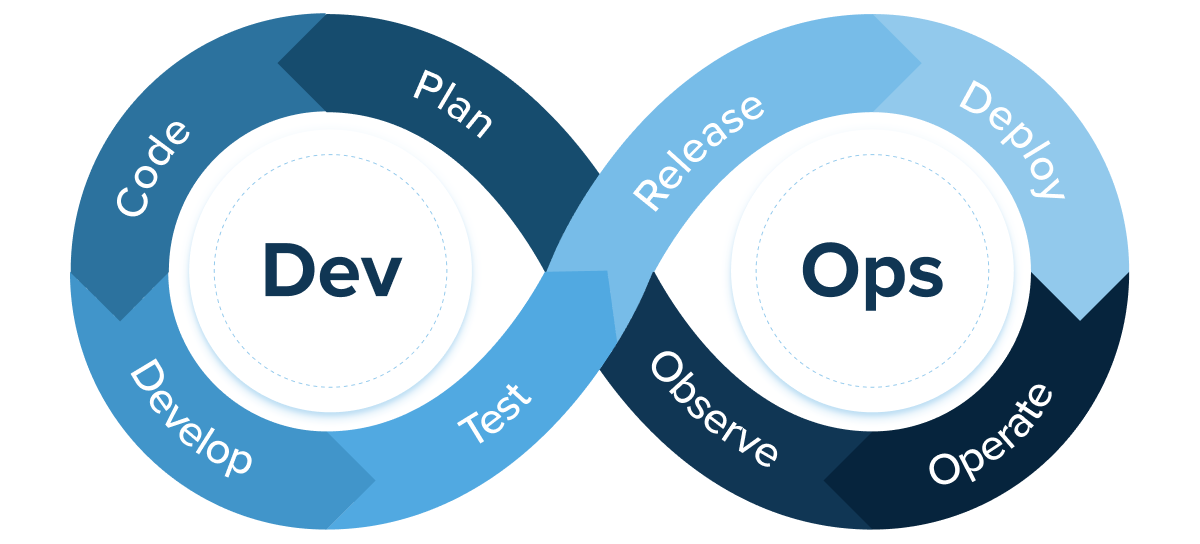Recently, DevOps as a Service (DaaS) has gradually become more popular than the traditional version of DevOps and is even prognosed to have a bright future because of artificial intelligence and natural language processing. But how has it happened? In this article, you will learn what DevOps and DaaS are, how they differ from each other, and why more and more businesses prefer the latter.
What are the principles of DevOps?

For many years, the tech industry has faced the problem of silos. DevOps removes it by developing end-to-end operations tailored for veracity. As the roles of development and administration are mixed together, teams have constant integration and delivery, which allows them to deploy updates for their projects faster.
The DevOps methodology consists of four principles that enhance your business evaluation models:
- Efficiency: DevOps estimates the company-wide practices’ performance to spot areas that need improvement. If they can drive faster outcomes, DevOps specialists take actions to reap all the benefits.
- Automation: Manual execution is time-consuming and has high risks of delays and inattentive mistakes. Automation allows for speeding up all the processes that can be handled without humans, resulting in rapid delivery and improved adaptability.
- Feedback: Proper management should take into consideration the needs of all stakeholders, including customers and developers. DevOps utilizes effective response channels with all sides to tailor projects that comply with all modern standards.
- Holistic collaboration: DevOps helps to unite developers who focus on code with operations that improve processes to create skilled and knowledgeable team members aligned with strategic execution.
Signs your business needs DevOps
DevOps includes various tools to advance an integrated work environment. If your business has faced these problems, applying DevOps will be your best choice:
Deployments are manual
There are still some practices that require human handling, but the majority of them, especially routine tasks, can be replaced by automation. If your business suffers from errors and slow processes, then you should try the DevOps approach, one of the key tenets of which is automation.

Source: Unsplash
Deployment activity is minimal
In a robust development pipeline, release cycles are swift, steady, and ongoing. If your projects suffer from slow deployments, then you need DevOps that allows faster delivery because of its adaptability and flexibility.
Ineffective management
It’s essential today to establish a well-functioning feedback loop that enables teams to identify and address challenges independently. If your organizational feedback still lacks constructive feedback, then you should apply DevOps to improve your organization.
Deployments are always impeded
If your deployments regularly hit snags, take a look at DevOps, which helps to combine all parts of the pipeline. As a result, your delivery processes become highly effective with systematic code releases and connected testing.
What is DevOps as a Service?
DevOps as a Service (DaaS) can be described as DevOps delivered through available on-demand as a service and scalable cloud platforms.
As a result, you can save money and utilize DevOps expertise, processes, and tools without the need to develop and manage them all in-house, because DaaS offers pre-configured tools and platforms delivered as a service.
Sometimes, it is called the new generation of DevOps and the future of business intelligence, as it allows businesses to leverage the benefits of a new IT framework with less risk.

By utilizing cloud services, DaaS significantly streamlines service delivery, providing flexibility and agility, as all services are stored in a cloud-based environment. All departments, including testers, developers, SREs, and operations, could seamlessly access the whole pipeline, with all important commercial deployment processes fully automated.
How does DaaS differ from traditional DevOps?
As with traditional DevOps, DaaS combines the same practices, such as monitoring, CI/CD, automation, and infrastructure as code. The main difference is that they are provided by external experts or platforms, rather than an in-house team.
A traditional DevOps setup usually requires hiring DevOps specialists to develop your own automation scripts, monitoring solutions, and CI/CD servers internally. DaaS allows most of this work to be handled with an external service. This might include partnering with a reliable DevOps service provider or implementing a cloud-based DevOps toolchain to construct and manage your pipeline.

You still get the same benefits, like constant delivery and integration, but without the need to control advanced in-house infrastructure or hire one more team to achieve it. This difference helps many businesses to cut down expenses and speed up the onboarding of DevOps practices.
Key benefits of adopting DevOps as a Service
Adopting DevOps as a Service can bring numerous advantages to your business, especially if you implement DevOps for the first time. Here are some key benefits:
Cost efficiency
Typically, DaaS users pay on a usage basis or a subscription, which is more cost-effective than building and maintaining a full in-house DevOps team and infrastructure. You also avoid significant upfront investments in salaries and servers, as you pay for what you need based on real-time demand.
This scalable cost structure and the minimization of capital expenses on licenses and hardware can considerably lower expenses. Many businesses simply don’t need to maintain a full-time DevOps team on continuous payroll, while a service model allows you to pay for it only when it is needed.

Source: Unsplash
Best practices and continuous updates
When utilizing cloud-based DevOps as a service, you get a perpetually maintained platform with constant updates. The service provider handles patching, tool maintenance, and ongoing improvements, so you don’t need to put extra effort into getting the latest DevOps capabilities.
For example, you don’t have to check your CI server to keep it up-to-date—DaaS allows you to seamlessly install all the upgrades to make sure your DevOps as a Service business model is relevant with minimal effort. You also get innovative practices from providers that offer only proven templates and processes.
Faster setup and time-to-market
One of the key DevOps as a service benefits your business will get is quicker releases, as you don’t have to build a pipeline internally—a DaaS provider will do it for you, and much faster.
A skilled team will get down to your project immediately after signing a contract, so you will see DevOps as a Service in action pretty fast and with minimal effort. All in all, this process speeds up your software delivery and allows you to speed up the launch of new features to customers.

Source: Unsplash
Access to industry experts
With DaaS, you don’t need to hire and train in-house DevOps specialists to get their expertise. DevOps as a Service providers employ qualified professionals with wide-ranging expertise, so you can get the best practices from day one.
Enhanced quality and monitoring
Utilizing DaaS means not only deploying a CI/CD system but also developing powerful logging, testing, and monitoring frameworks as part of the service, so you can get a robust deployment pipeline with real-time feedback loops and automated testing.
Proactive testing finds errors before release, while real-time monitoring smoothly finds faults in production, which leads to elevated software quality and stable deployments. As a result, you get a top-notch pipeline tailored for effectiveness and error detection.
Scalability and flexibility
DaaS can boast high scalability, which helps to deal with a new product launch or a rise in development projects. You can entrust your pipelines to your external team or a platform, because they can both scale them up and adapt the level of service to fit your demands.
Also, DevOps platform as a service is usually modular, which means you can use only the tools you need and include new ones in time. These benefits allow you to always have the perfect size for your business to develop.
It should be mentioned that, like any other technology, DaaS also has several challenges, for example, the need to delegate the handling of confidential information to a third party or less direct control.
Nevertheless, experienced providers can mitigate these challenges by applying security measures and clear communication. All in all, such advantages as cost savings, speed, and expertise make DevOps as a Service a perfect choice for companies that want to reap the benefits of DevOps quickly and with a minimal budget.
Who benefits most from DevOps as a Service model?
DevOps as a Service is a versatile tool that can be useful for organizations from almost all industries. However, there are some cases where its effectiveness is the most impressive. Here they are:
Expanding companies
It’s a complicated task for an engineering team to stay in the loop with infrastructure and deployment needs when a business scales rapidly. As the number of developers increases and the codebase expands, companies in growth often face difficulties in their release cycles. If this is your case, DevOps can be your help.
DevOps as a service providers can prevent the deployment from becoming an obstacle for growth by swiftly deploying scalable pipelines. Even the companies that don’t want to hire a big DevOps department can benefit from it by temporarily utilizing these capabilities via service.

Source: Unsplash
Teams facing tight deadlines
In situations where a development team needs to stabilize the deployment process or prepare a major product release, every minute counts, and hiring extra staff may take time, which companies simply don’t have.
In this case, adopting DevOps as a service will be a quick solution to resolve the situation. DaaS providers have extensive experience and templates that allow them to fulfill your needs promptly and get pipelines running faster than if you were to build an internal team.
Businesses lacking in-house expertise
Every successful company has a team of professionals who can build robust products based on what they are expert in.
However, not every company has DevOps specialists in its IT department, which creates risks of not keeping up with the latest cloud or CI/CD tools. If you don’t need such experts permanently, take a look at a DaaS provider, which gives you professionals who mitigate these risks by offering processes your business needs right now.
Small-to-medium businesses and startups
Startups and smaller businesses often face the problem of either lacking the time needed to build an intricate toolchain from scratch or the budget to establish a dedicated in-house DevOps team.

DevOps as a Service technology trends
As DevOps as a Service business model is becoming more and more popular, this service is constantly developing. Here are key technology trends you may use to prosper:
AI and automation in DevOps (AIOps)
Automation has always been an integral part of DevOps, but now it is rapidly developing to become a mix with AI. Nowadays, machine learning for smarter automation is becoming more popular, as it allows automating anomaly detection in CI/CD pipelines, handling code testing with the use of AI, and identifying project error occurrences.
All in all, it helps organizations to handle the increasing complexity of system architecture without extra risks. It is predicted that DaaS will upgrade pipelines with the use of AI, which will free up companies from the need to spend large sums of money on traditional DevOps. If you own an AI company, take a look at DaaS, as collaborating with it can be beneficial for your business.
Built-in security, compliance, and governance
As governments are tightening security laws every year, the question of high security has become one of the most important for modern, prosperous companies. This is why DevSecOps is becoming more popular. This approach ensures code is secure from development to its release. Nowadays, security should match a team’s professionalism, and DevSecOps helps with it.
GitOps and automation
Traditionally, CI/CD approaches included manual configuration and imperative scripts. Nowadays, even small businesses have to handle huge amounts of data and have to be very precise and careful with it so as not to lose their clients.
Sadly, this approach has become outdated, as it is pretty complicated to audit and prone to human error. If you want to automate your workflow, try GitOps, which allows using Git repositories to store declarative configurations. As a result, your business gets more traceability, reliability, and collaboration.
Conclusion
DevOps as a Service has undoubtedly become a game-changer in software development, as it has allowed startups and small businesses to get the advantages of continuous delivery and automation that previously were accessible only to large companies by combining managed services, data architecture, cloud-based platforms, and machine learning consulting insights.
As a result, DaaS allows your development team to focus not on operational difficulties but on delivering value. No matter what purpose you it, DaaS will definitely change your business for the better.
FAQ
-
DevOps as a Service is a cloud-based model that provides DevOps tools and practices as managed services, so companies don’t need to spend large sums of money on building a full in-house team to have DevOps in their workflow.
-
There are a lot of good examples of DaaS, the use of which allows you to streamline your deployment processes. Two of the most famous ones are Azure DevOps as a service and AWS DevOps as a service.
-
By utilizing DevOps as a Service, you can basically get the same benefits as from traditional DevOps, but for a smaller price, as all you need is stored on cloud-based services.
All in all, you will get such benefits as high expertise, advanced time to market, built-in security and compliance, continuous improvement, cost efficiency, enhanced collaboration, and scalability and flexibility.
-
Usually, DevOps is not divided into types like databases or programming languages, but it still has different approaches based on organizational needs. Here they are:
- AIOps (artificial intelligence)
- DevSecOps (security practices)
- MLOps (machine learning workflows)
- NoOps (full automation)
- TestOps (automated testing)
- GitOps (git repositories)
- Platform Engineering (the development of internal developer platforms).



